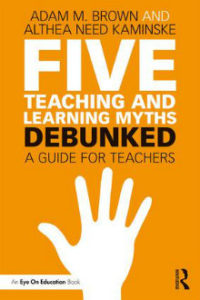5 Teaching, Learning Myths “Debunked”
Five Teaching and Learning Myths Debunked: A Guide for Teachers
By Adam M. Brown and Althea Need Kaminski
(Routledge?Eye On Education, 2018 – Learn more)

Are you a multitasker? Do you use examples to make learning more relatable? Do you teach to learning styles? Do you keep your cell phone in reach at school?
If you answered yes to one or more of these questions, you might be interested in Adam Brown and Althea Kamisnksi’s Five Teaching and Learning Myths—Debunked. But, I am warning you – you might not like what they have to say.
The Myths

The tools are grouped into early elementary, late elementary, middle school, and high school/college applications.
Multitasking
Okay. this won’t surprise you. The authors say that multitasking doesn’t work. Teachers, we’ve heard it before and we’ll hear it again. When we multitask, we shortchange everything and instead of getting more bang for our buck, we end up with chump change.
But I have to tell you, as life-long multitasker who is successful both personally and professionally, I don’t care what anyone says. In fact right now I am typing this, listening to an audiobook, and painting my fingernails. So there.
To be fair, the authors are not really talking about teachers multitasking; rather, they consider how we can help students focus on one task at a time to increase and deepen learning. The tools they offer, for the most part, are designed to help students take breaks in the active learning process to filter and reflect on new learnings.
Examples
Using examples in our teaching does not help students generalize or make lessons more interesting. In fact, the research shows that when we offer examples students tend to focus on the more trivial aspects of the example – the authors call these the “seductive details” – rather than the important content we had in mind. Similarly, when we offer entertaining examples to get students excited about a topic, it can have a diminishing effect as attention is pulled from the actual learning target to the seductive details.
The tools offered here seem to conflict with the point of the chapter, as they include ideas such as using multiple examples, explaining examples, and asking for student-generated examples.
Focus
The authors are not saying focus is a myth. Rather, they are exploring common myths related to how we focus. For example, they debunk the notion that the ability to focus is a trait some are born with and some are not born with and that to focus one needs a quiet space. They share that focus can be taught and strengthened. I think most would agree that focus is a skill than can be honed. That said, as a person who has ADHD (and is medicated for it, thank you very much), I do know that there is a biological component to focus as well.
The book’s tools for focus are very similar to those in the first chapter on multitasking but also include strategies for staying on top of tasks.
Testing
This chapter, which debunks the myth that testing is bad, is not likely to surprise any working educator. The main idea: testing, when used well, can be a critical tool to improve learning. The authors stay away from the controversy of standardized tests and tests used in high-stakes ways. They focus on testing that serves to check student progress in relation to given learning targets.
The tools offered for all levels are variations on fun formative assessment strategies designed not only to help the teacher gauge learning progress but also to alleviate testing anxiety in children. I think we can all agree – assessment is and important teaching tool.
Learning Styles
For me, this chapter made the whole book worth reading! Despite the fact that the concept of “learning styles” (visual, kinesthetic, linguistic learners) has repeatedly been debunked in studies, teachers seem to be unwilling to let it go! The authors explain that learners cannot be placed neatly in any one learning style box. Further, when teachers identify students as having a preferred style and teach to it, they actually do harm.
The tools, however, do not do the topic justice. The bottom line is that lessons incorporating different ways to learn are a good thing. There should be visuals, multiple voices sharing information, texts, and movement-based learning. To that end, the authors share a smattering of inchoate suggestions for including different presentation styles but none resonate as particularly helpful for immediate implementation.
Five Teaching and Learning Myths Debunked: A Guide for Teachers is a quick read, and it is interesting enough. It might spark some productive discussion in a professional learning community looking to jettison common but misguided strategies in favor of research-based best practices. Perhaps brainstorming some other tools and resources could be part of that discussion.
Rita Platt (@ritaplatt) is a National Board Certified Teacher with master’s degrees in reading, library, and leadership. Her experience includes teaching learners in remote Alaskan villages, inner cities, and rural communities. She currently is a school principal, teaches graduate courses for the Professional Development Institute and blogs at Heart of the School for MiddleWeb. Her new book, Working Hard, Working Happy: Cultivating a Culture of Effort and Joy in the Classroom, launches in early July.




































